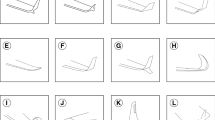Abstract
Experimental aerodynamic investigations of the NASA Common Research Model have been conducted in the NASA Langley National Transonic Facility and the European Transonic Wind Tunnel. Data have been obtained at chord Reynolds numbers of 5, 19.8 and 30 million for the wing/body/tail = 0° incidence configuration in the National Transonic Facility and in the European Transonic Wind Tunnel. Force and moment, surface pressure, wing bending and twist, and surface flow visualization data were obtained in both facilities but only the force and moment, and surface pressure data are presented herein.













Similar content being viewed by others
Abbreviations
- b :
-
Wing span
- c :
-
Wing mean aerodynamic chord
- C D :
-
Drag coefficient
- C L :
-
Lift coefficient
- C m :
-
Pitching moment coefficient referenced to 0.25 of the wing mean aerodynamic chord
- C p :
-
Pressure coefficient
- CRM:
-
Common Research Model
- DPW:
-
Drag prediction workshop
- E :
-
Modulus of elasticity
- ESWIRP :
-
European Strategic Wind Tunnels Improved Research Potential
- M ∞ :
-
Freestream Mach number
- NTF:
-
National Transonic Facility
- p t :
-
Total pressure
- q ∞ :
-
Dynamic pressure
- Re c :
-
Reynolds number based on mean aerodynamic chord
- S :
-
Model reference area
- T t :
-
Total temperature
- WBT0:
-
Wing/body/tail = 0°
- x/c :
-
Longitudinal distance from wing leading edge nondimensionalized by local wing chord
- α :
-
Angle of attack, degree
- η :
-
Fraction of wing semi-span
References
Lutz, T., Gansel, P., Godard, J.-L., Gorbushin, A., Konrath, R., Quest, J., Rivers, S.: Going for Experimental and Numerical Unsteady Wake Analyses Combined with Wall Interference Assessment Using the NASA CRM Model in ETW. AIAA Paper 2013-0871, 51st AIAA Aerospace Sciences Meeting including the New Horizons Forum and Aerospace Exposition, Grapevine, TX, January 2013
Konrath, R.: High-Speed PIV Applied to Wake of NASA CRM Model in ETW Under High Re-Number Stall Conditions for Sub- and Transonic Speeds. AIAA Paper 2015-1095, 53rd AIAA Aerospace Sciences Meeting, Kissimmee, FL, January 2015
Gloss, B.B.: Current Status and Some Future Test Directions for the US National Transonic Facility. Wind Tunnels and Wind Tunnel Test Techniques, pp. 3.1–3.7. Royal Aeronautical Society, London, United Kingdom (1992)
Fuller, D.E. (1981) Guide for Users of the National Transonic Facility. NASA TM-83124
Vassberg, J.C., DeHaan, M.A., Rivers, S.M., Wahls, R.A.: Development of a Common Research Model for Applied CFD validation studies. AIAA Paper 2008-6919, 26th AIAA Applied Aerodynamics Conference, Honolulu, HI, August 2008
Iyer, V.: A Wall Correction Program Based on Classical Methods for the National Transonic Facility (Solid Wall or Slotted Wall) and the 14 × 22-Ft Subsonic Tunnel at NASA LaRC. NASA/CR 2004-213261, October 2004
Gross, N., Quest, J.: The ETW Wall Interference Assessment for Full and Half Models. AIAA Paper 2004-0769, 42nd AIAA Aerospace Sciences Meeting and Exhibit, Reno, NV, January 2004
Author information
Authors and Affiliations
Corresponding author
Rights and permissions
About this article
Cite this article
Rivers, M., Quest, J. & Rudnik, R. Comparison of the NASA Common Research Model European Transonic Wind Tunnel test data to NASA National Transonic Facility test data. CEAS Aeronaut J 9, 307–317 (2018). https://doi.org/10.1007/s13272-017-0250-7
Received:
Revised:
Accepted:
Published:
Issue Date:
DOI: https://doi.org/10.1007/s13272-017-0250-7




